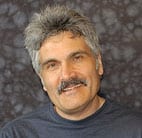As a human health issue, most people think about metabolism in the context of calories in/calories out, energy consumption and body weight. But lately, scientists are finding far more sweeping health implications for this biological process.
With metabolic pathways now seen as essential players in human development and aging, as well as common diseases such as cancer, diabetes and Alzheimer’s, metabolism has become a wellspring of new knowledge for biologists.

This enzyme identified by Luigi Puglielli, associate professor of medicine, plays a role in the molecular degeneration that takes place in Alzheimer’s disease. Puglielli is developing compounds that could help block Alzheimer’s.
In terms of excitement and possibilities, the field today could fairly be compared to stem cell research 15 years ago, or recombinant DNA research a few decades ago. Often called the “chemistry of life,” metabolism provides the biochemical building blocks for cell growth, development and death, but there are still huge gaps in understanding.
The renaissance can be seen at the University of Wisconsin–Madison, where an estimated 100-plus scientists are studying core aspects of metabolism, and many others have some peripheral connection. It’s the impetus for a new initiative led by the Morgridge Institute for Research to provide leadership, infrastructure and community building in the field.
“The field is really cooking right now,” says Alan Attie, professor of biochemistry who studies metabolic issues in Type 2 diabetes. “We’re taking topics that were thought to be kind of worn-out and old-fashioned, dusting them off and realizing there is way more to it than anyone imagined.”
Biochemistry Professor Dave Pagliarini says only a decade ago, metabolism was “relegated to memorizing the canonical pathways in cells,” and seen as something already known and defined. Now scientists are discovering new metabolites and pathways — and disproving old ones — all the time.
“As new tools gave us new insights,” Pagliarini says, “it became clear and in retrospect should have been obvious that most diseases have at their core metabolic defects.”
UW–Madison’s metabolism research environment is diverse, with active projects at the clinical, bench and computational levels. Here is s snapshot of five metabolism scientists from different parts of campus.
Dave Pagliarini: Revisiting mitochondria, the cellular powerhouse

“If your car breaks down and you pop the hood and a quarter of the parts have no meaning, you’re not likely to solve the problem,” he says.
“What we do in our laboratory is try to find systematic ways to annotate those parts and proteins — what do they do, what are their biochemical roles, and how do mutations give rise to human diseases. I want to fundamentally understand how these metabolic hubs operate.”
Mitochondria produce 90 percent of adenosine triphosphate, or ATP, the chemical currency of our bodies. It uses 90 percent of the oxygen we breathe to make ATP. The “cellular powerhouse” role is well-established, but mitochondria also play a role in more than 150 diseases, from rare inborn disorders to Parkinson’s, diabetes and cancer.
Because mitochondria are double-membrane entities within the cell, they offer both therapeutic challenges and opportunities. While difficult to get therapeutic targets past this extra barricade, the fact that it’s a stand-alone entity might make therapies more precise. For now, Pagliarini says there are no effective treatments for mitochondrial disorders but there are major initiatives under way, and a better “systems level” understanding will contribute to their success.
Rozalyn Anderson: Caloric restriction to alter the path of aging

“My lab works on how caloric restriction impacts longevity to extend lifespan and prevent the onset of age-related disease,” she says. “It’s remarkable really, caloric restriction’s beneficial effects are observed across the whole gamut of diseases and disorders, including cancer, neurodegenerative disease and inflammatory disease,” For example, caloric restriction produces a “non-permissive tumor environment,” which limits the spread of tumors and possibly can reverse the spread of cancer.
“We now think that caloric restriction creates a very different metabolic state,” Anderson says. “In its essence, age-related disease vulnerability is tightly linked to the loss of metabolic integrity,” she says. “That leads to everything else. I have a very metabolism-centric view of the world.”
In work with monkeys and mouse models, Anderson’s research focuses on the next big question: How does caloric restriction work? That answer is centered around dysfunction in the mitochondria, which is a major trigger for disease and mortality. Her team is working to discover how caloric restriction staves off that dysfunction and whether they can identify the key players in that mechanism.
Alan Attie: The genetics of Type 2 diabetes

Says Attie: “We look at this dichotomy from a genetic point of view and ask: What are the genes that determine whether or not an obese animal will develop diabetes?”
Attie developed a highly diverse model strain of mice that have all the traits necessary to study this question – one group that is diabetic when obese, and one that is not. And they have identified and mapped a number of genes that contribute to diabetes.
“These mice strains contain as much genetic diversity as the entire human population, so it’s a very nice genetic resource to look for variations in genes that contribute to diabetes-related phenotypes,” Attie says.
Attie says this mouse population could be a campus resource for many types of disease models, including heart disease, cancer and infectious disease. “It’s all where you shine the light.”
Jennifer Reed: Engineering metabolism to create useful products

Cyanobacteria can carry out photosynthesis, which allows them to use sunlight and CO2 to directly make biofuels. “In the case of most biofuels, you’re growing the plant material, breaking the plant material down into sugars, and then using microbes to convert the sugars into useful fuels and chemicals,” she says. “Cyanobacteria are nice because you can carry out all the necessary metabolic reactions in one organism.”
Reed creates computational models that attempt to predict how these organisms will function and grow in different environmental conditions, or with different genetic tweaks. Reed uses information from an organism’s genome and metabolic network to run thousands of different simulations and determine the best genetic tweaks and conditions to produce useful byproducts.
Her models have applications in other metabolism labs, including a study of how salmonella grows on alfalfa plants and how microbes enhance probiotic properties in dairy products. “Metabolism changes in these organisms and is very condition-dependent,” she says. “We’re still filling in the pieces on how these networks operate.”
Luigi Puglielli: Finding the molecular culprits in Alzheimer’s Disease

Puglielli focuses on the metabolism of acetylCoA and the acetylation of proteins in the endoplasmic reticulum (ER), which functions as a manufacturing and packaging system for making new proteins. The ER has the remarkable ability to conduct “quality control” on proteins and reject those that have some sort of dysfunction, such as improper folding. Puglielli has identified flaws in this process in cells from mice that have Alzheimer’s.
He also has identified small compounds that can target the “quality control” machinery and help the ER dispose of toxic aggregates. These compounds are essentially able to prevent Alzheimer’s in the mouse model. In the mice models with Alzheimer’s and no treatment, 50 percent die after 16 months — comparable to a human at age 70. The mice given the compound all survive.
A spinoff company, Jace Biomedical, is working on developing this novel compound and moving it closer to human clinical trials. Puglielli notes that Alzheimer’s can’t be treated after the fact — when a neuron dies, it can’t be regenerated — so his process focuses on preventive maintenance, much like a hypertension or cholesterol-lowering drug.
Several important factors must be addressed before this compound could offer hope for Alzheimer’s patients, who number more than 5 million in the United States alone. First, he says, medicine must develop a much more sophisticated risk profile to identify potential symptoms early; and any compound must be proven to have low side effects over 20-30 years of use.
“We want to slow down the progression of Alzheimer’s so that you are not getting the disease at the age of 60, you’re getting it at the age of 120 — basically allowing you to lead a normal life,” he says.
